Fluoride Treatment and In Vitro Corrosion Behavior of Mg-Nd-Y-Zn-Zr Alloys Type
Abstract
:1. Introduction
2. Materials and Methods
2.1. Sample Preparation
2.2. Materials Characterization—Structural and Surface Analysis
2.3. Electrochemical Tests
2.4. Immersion Test
3. Results and Discussions
3.1. Materials Characterization—Structural and Surface Analysis
3.1.1. Scanning Electron Microscopy—Energy Dispersive X-ray Spectroscopy
3.1.2. XRD
3.1.3. Contact Angle
3.2. Electrochemical Corrosion Behavior
3.3. Immersion Tests
4. Discussions
- For both investigated magnesium alloys the sandblasting treatment leads to a worsening of corrosion resistance.
- After chemical treatment with HF of initial surfaces, both investigated magnesium alloys exhibit the lowest corrosion current density and highest polarization resistance.
- After the chemical treatment with HF of sandblasted surfaces the corrosion resistance is highly improved for both magnesium alloys.
5. Conclusions
Author Contributions
Funding
Institutional Review Board Statement
Informed Consent Statement
Data Availability Statement
Conflicts of Interest
References
- Wu, S.; Liu, X.; Yeung, K.W.K.; Guo, H.; Li, P.; Hu, T.; Chung, C.Y.; Chu, P.K. Surface Nano-Architectures and Their Effects on the Mechanical Properties and Corrosion Behavior of Ti-Based Orthopedic Implants. Surf. Coat. Technol. 2013, 233, 13–26. [Google Scholar] [CrossRef]
- Rau, J.V.; Antoniac, I.; Cama, G.; Komlev, V.; Ravaglioli, A. Bioactive Materials for Bone Tissue Engineering. BioMed Res. Int. 2016, 2016, 1–3. [Google Scholar] [CrossRef] [PubMed]
- Cofaru, N.F.; Roman, M.D.; Cofaru, I.I.; Oleksik, V.S.; Fleaca, S.R. Medial Opening Wedge High Tibial Osteotomy in Knee Osteoarthritis—A Biomechanical Approach. Appl. Sci. 2020, 10, 8972. [Google Scholar] [CrossRef]
- Ionescu, R.; Cristescu, I.; Dinu, M.; Saban, R.; Antoniac, I.; Vilcioiu, D. Clinical, Biomechanical and Biomaterials Approach in the Case of Fracture Repair Using Different Systems Type Plate-Screw. Key Eng. Mater. 2014, 583, 150–154. [Google Scholar] [CrossRef]
- Dinu, M.; Pana, I.; Scripca, P.; Sandu, I.G.; Vitelaru, C.; Vladescu, A. Improvement of CoCr Alloy Characteristics by Ti-Based Carbonitride Coatings Used in Orthopedic Applications. Coatings 2020, 10, 495. [Google Scholar] [CrossRef]
- Liu, S.; Chen, C.; Chen, L.; Zhu, H.; Zhang, C.; Wang, Y. Pseudopeptide Polymer Coating for Improving Biocompatibility and Corrosion Resistance of 316L Stainless Steel. RSC Adv. 2015, 5, 98456–98466. [Google Scholar] [CrossRef]
- Miculescu, F.; Bojin, D.; Ciocan, L.T.; Antoniac, I.; Miculescu, M.; Miculescu, N. Experimental Researches on Biomaterial-Tissue Interface Interactions. J. Optoelectron. Adv. Mater. 2007, 9, 3303–3306. [Google Scholar]
- Roman, M.D.; Fleaca, R.S.; Boicean, A.; Bratu, D.; Birlutiu, V.; Rus, L.L.; Tantar, C.; Mitariu, S.I.C. Assesment of Synovial Fluid pH in Osteoarthritis of the HIP and Knee. Rev. Chim. 2017, 68, 1242–1244. [Google Scholar] [CrossRef]
- Dorozhkin, S.V. Calcium Orthophosphate Coatings on Magnesium and Its Biodegradable Alloys. Acta Biomater. 2014, 10, 2919–2934. [Google Scholar] [CrossRef]
- Rau, J.V.; Antoniac, I.; Filipescu, M.; Cotrut, C.; Fosca, M.; Nistor, L.C.; Birjega, R.; Dinescu, M. Hydroxyapatite Coatings on Mg-Ca Alloy Prepared by Pulsed Laser Deposition: Properties and Corrosion Resistance in Simulated Body Fluid. Ceram. Int. 2018, 44, 16678–16687. [Google Scholar] [CrossRef]
- Antoniac, I.; Miculescu, F.; Cotrut, C.; Ficai, A.; Rau, J.V.; Grosu, E.; Antoniac, A.; Tecu, C.; Cristescu, I. Controlling the Degradation Rate of Biodegradable Mg–Zn-Mn Alloys for Orthopedic Applications by Electrophoretic Deposition of Hydroxyapatite Coating. Materials 2020, 13, 2020. [Google Scholar] [CrossRef] [PubMed] [Green Version]
- Yang, Y.; He, C.; Dianyu, E.; Yang, W.; Qi, F.; Xie, D.; Shen, L.; Peng, S.; Shuai, C. Mg Bone Implant: Features, Developments and Perspectives. Mater. Des. 2020, 185, 108259. [Google Scholar] [CrossRef]
- Resoloy: A Magnesium Alloy for Absorbable Devices—Fort Wayne Metals. Available online: https://www.fwmetals.com/services/r-d/rd-update/previous-rd-updates/resoloy-a-magnesium-alloy-for-absorbable-devices/ (accessed on 16 October 2021).
- Stegen, S.; van Gastel, N.; Carmeliet, G. Bringing New Life to Damaged Bone: The Importance of Angiogenesis in Bone Repair and Regeneration. Bone 2015, 70, 19–27. [Google Scholar] [CrossRef] [PubMed]
- Chen, Y.; Xu, Z.; Smith, C.; Sankar, J. Recent Advances on the Development of Magnesium Alloys for Biodegradable Implants. Acta Biomater. 2014, 10, 4561–4573. [Google Scholar] [CrossRef]
- Windhagen, H.; Radtke, K.; Weizbauer, A.; Diekmann, J.; Noll, Y.; Kreimeyer, U.; Schavan, R.; Stukenborg-Colsman, C.; Waizy, H. Biodegradable Magnesium-Based Screw Clinically Equivalent to Titanium Screw in Hallux Valgus Surgery: Short Term Results of the First Prospective, Randomized, Controlled Clinical Pilot Study. Biomed. Eng. OnLine 2013, 12, 62. [Google Scholar] [CrossRef] [Green Version]
- Zhao, D.; Witte, F.; Lu, F.; Wang, J.; Li, J.; Qin, L. Current Status on Clinical Applications of Magnesium-Based Orthopaedic Implants: A Review from Clinical Translational Perspective. Biomaterials 2017, 112, 287–302. [Google Scholar] [CrossRef] [PubMed]
- Zhao, D.; Huang, S.; Lu, F.; Wang, B.; Yang, L.; Qin, L.; Yang, K.; Li, Y.; Li, W.; Wang, W.; et al. Vascularized Bone Grafting Fixed by Biodegradable Magnesium Screw for Treating Osteonecrosis of the Femoral Head. Biomaterials 2016, 81, 84–92. [Google Scholar] [CrossRef]
- Lee, J.-W.; Han, H.-S.; Han, K.-J.; Park, J.; Jeon, H.; Ok, M.-R.; Seok, H.-K.; Ahn, J.-P.; Lee, K.E.; Lee, D.-H.; et al. Long-Term Clinical Study and Multiscale Analysis of in Vivo Biodegradation Mechanism of Mg Alloy. Proc. Natl. Acad. Sci. USA 2016, 113, 716–721. [Google Scholar] [CrossRef] [Green Version]
- Zhang, Y.; Xu, J.; Ruan, Y.C.; Yu, M.K.; O’Laughlin, M.; Wise, H.; Chen, D.; Tian, L.; Shi, D.; Wang, J.; et al. Implant-Derived Magnesium Induces Local Neuronal Production of CGRP to Improve Bone-Fracture Healing in Rats. Nat. Med. 2016, 22, 1160–1169. [Google Scholar] [CrossRef] [PubMed]
- Wu, S.; Liu, X.; Yeung, K.W.K.; Liu, C.; Yang, X. Biomimetic Porous Scaffolds for Bone Tissue Engineering. Mater. Sci. Eng. R Rep. 2014, 80, 1–36. [Google Scholar] [CrossRef]
- Fadeeva, I.V.; Kalita, V.I.; Komlev, D.I.; Radiuk, A.A.; Fomin, A.S.; Davidova, G.A.; Fursova, N.K.; Murzakhanov, F.F.; Gafurov, M.R.; Fosca, M.; et al. In Vitro Properties of Manganese-Substituted Tricalcium Phosphate Coatings for Titanium Biomedical Implants Deposited by Arc Plasma. Materials 2020, 13, 4411. [Google Scholar] [CrossRef]
- Biber, R.; Pauser, J.; Geßlein, M.; Bail, H.J. Magnesium-Based Absorbable Metal Screws for Intra-Articular Fracture Fixation. Case Rep. Orthop. 2016, 2016, 9673174. [Google Scholar] [CrossRef] [PubMed] [Green Version]
- Antoniac, I.; Adam, R.; Bita, A.; Miculescu, M.; Trante, O.; Petrescu, I.M.; Pogarasteanu, M. Comparative Assessment of in vitro and in vivo Biodegradation of Mg-1Ca Magnesium Alloys for Orthopedic Applications. Materials 2021, 14, 1–20. [Google Scholar] [CrossRef] [PubMed]
- Hewei, C.; Bo, Y.; Rui, Z.; Xiao, Y.; Zhanwen, X.; Antoniac, A.; Bita, A.I.; Xiangdong, Z.; Antoniac, V.I.; Xingdong, Z. Evaluation on the Corrosion Resistance, Antibacterial Property and Osteogenic Activity of Biodegradable Mg-Ca and Mg-Ca-Zn-Ag Alloys. J. Magnes. Alloys 2021, 1–17, in press. [Google Scholar] [CrossRef]
- Chakraborty Banerjee, P.; Al-Saadi, S.; Choudhary, L.; Harandi, S.E.; Singh, R. Magnesium Implants: Prospects and Challenges. Materials 2019, 12, 136. [Google Scholar] [CrossRef] [PubMed] [Green Version]
- Song, G. Control of Biodegradation of Biocompatable Magnesium Alloys. Corros. Sci. 2007, 49, 1696–1701. [Google Scholar] [CrossRef]
- Radha, R.; Sreekanth, D. Insight of Magnesium Alloys and Composites for Orthopedic Implant Applications—A Review. J. Magnes. Alloys 2017, 5, 286–312. [Google Scholar] [CrossRef]
- Chen, J.; Tan, L.; Yu, X.; Etim, I.P.; Ibrahim, M.; Yang, K. Mechanical Properties of Magnesium Alloys for Medical Application: A Review. J. Mech. Behav. Biomed. Mater. 2018, 87, 68–79. [Google Scholar] [CrossRef] [PubMed]
- Brar, H.S.; Ball, J.P.; Berglund, I.S.; Allen, J.B.; Manuel, M.V. A Study of a Biodegradable Mg–3Sc–3Y Alloy and the Effect of Self-Passivation on the in Vitro Degradation. Acta Biomater. 2013, 9, 5331–5340. [Google Scholar] [CrossRef] [PubMed]
- Zhu, Y.; Wu, G.; Zhang, Y.-H.; Zhao, Q. Growth and Characterization of Mg(OH)2 Film on Magnesium Alloy AZ31. Appl. Surf. Sci. 2011, 257, 6129–6137. [Google Scholar] [CrossRef]
- Lorenz, C.; Brunner, J.G.; Kollmannsberger, P.; Jaafar, L.; Fabry, B.; Virtanen, S. Effect of Surface Pre-Treatments on Biocompatibility of Magnesium. Acta Biomater. 2009, 5, 2783–2789. [Google Scholar] [CrossRef]
- Mareci, D.; Bolat, G.; Izquierdo, J.; Crimu, C.; Munteanu, C.; Antoniac, I.; Souto, R.M. Electrochemical Characteristics Of Bioresorbable Binary MgCa Alloys in Ringer’s Solution: Revealing the Impact of Local Ph Distributions During In-Vitro Dissolution. Mater. Sci. Eng. C 2016, 60, 402–410. [Google Scholar] [CrossRef] [PubMed]
- Bita, A.I.; Stan, G.E.; Niculescu, M.; Ciuca, I.; Vasile, E.; Antoniac, I. Adhesion Evaluation of Different Bioceramic Coatings on Mg-Ca Alloys for Biomedical Applications. J. Adhes. Sci. Technol. 2016, 30, 1968–1983. [Google Scholar] [CrossRef]
- Neacsu, P.; Staras, A.; Voicu, S.I.; Ionascu, I.; Soare, T.; Seralp, U.; Cojocaru, V.D.; Pandele, A.; Croitoru, S.; Miculescu, F.; et al. Characterization and In vitro and In vivo Assessment of a Novel Cellulose Acetate-Coated Mg-Based Alloy for Orthopedic. Appl. Mater. 2017, 10, 686. [Google Scholar] [CrossRef] [PubMed] [Green Version]
- Hu, L.; Meng, Q.; Chen, S.; Wang, H. Effect of Zn Content on the Chemical Conversion Treatments of AZ91D Magnesium Alloy. Appl. Surf. Sci. 2012, 259, 816–823. [Google Scholar] [CrossRef]
- Drábiková, J.; Fintová, S.; Tkacz, J.; Doležal, P.; Wasserbauer, J. Unconventional Fluoride Conversion Coating Preparation and Characterization. Anti-Corros. Methods Mater. 2017, 64, 613–619. [Google Scholar] [CrossRef]
- Drynda, A.; Seibt, J.; Hassel, T.; Bach, F.W.; Peuster, M. Biocompatibility of Fluoride-Coated Magnesium-Calcium Alloys with Optimized Degradation Kinetics in a Subcutaneous Mouse Model. J. Biomed. Mater. Res. A 2013, 101A, 33–43. [Google Scholar] [CrossRef]
- Yan, T.; Tan, L.; Zhang, B.; Yang, K. Fluoride Conversion Coating on Biodegradable AZ31B Magnesium Alloy. J. Mater. Sci. Technol. 2014, 30, 666–674. [Google Scholar] [CrossRef]
- Yan, T.; Tan, L.; Xiong, D.; Liu, X.; Zhang, B.; Yang, K. Fluoride Treatment and In Vitro Corrosion Behavior of an AZ31B Magnesium Alloy. Mater. Sci. Eng. C 2010, 30, 740–748. [Google Scholar] [CrossRef]
- Bita, A.I.; Antoniac, A.; Cotrut, C.; Vasile, E.; Ciuca, I.; Niculescu, M.; Antoniac, I. In vitro Degradation and Corrosion Evaluation of Mg-Ca Alloys for Biomedical Applications. J. Optoelectron. Adv. Mater. 2016, 18, 394–398. [Google Scholar]
- Conceiçao, T.F.; Scharnagl, N.; Blawert, C.; Dietzel, W.; Kainer, K.U. Surface Modification of Magnesium Alloy AZ31 by Hydrofluoric Acid Treatment and its Effect on the Corrosion Behavior. Thin Solid Films 2010, 518, 5209–5218. [Google Scholar] [CrossRef] [Green Version]
- Pourbaix, M.; Muylder, J. Atlas D’Equilibres Electrochimiques; Gauthier-Villars: Paris, France, 1963. [Google Scholar]
- Miculescu, F.; Miculescu, M.; Ciocan, L.T.; Ernuteanu, A.; Antoniac, I.; Pencea, I.; Matei, E. Comparative Studies Regarding Heavy Elemenets Concentration in Human Bone. Dig. J. Nanomater. Biostructures 2011, 6, 1117–1127. [Google Scholar]
- Viswanathan, S.S. Recent Progress in Superhydrophobic and Superamphiphobic Coatings for Magnesium and its Alloys. J. Magnes. Alloys 2021, 9, 748–778. [Google Scholar] [CrossRef]
- Yingrui, L.; Zhang, K.; Zou, J.; Yan, P.; Zhang, X.; Song, L. Microstructure and Property Modifications in Surface Layers of a Mg-4Sm-2Al-0.5Mn Alloy Induced by Pulsed Electron Beam Treatments. J. Magnes. Alloys 2021, 9, 216–224. [Google Scholar] [CrossRef]
- ASTM International; ASTM G5-14e1. Standard Reference Test Method for Making Potentiostatic and Potentiodynamic Anodic Polarization Measurements. ASTM International: West Conshohocken, PA, USA, 2014.
- ASTM International. ASTM G102-89. Calculation of Corrosion Rates and Related Information from Electrochemical Measurements; ASTM International: West Conshohocken, PA, USA, 2015. [Google Scholar]
- Shi, Z.; Atrens, A. An Innovative Specimen Configuration for the Study of Mg Corrosion. Corros. Sci. 2011, 53, 226–246. [Google Scholar] [CrossRef]
- Rau, J.V.; Antoniac, I.; Fosca, M.; De Bonis, A.; Blajan, A.I.; Cotrut, C.; Graziani, V.; Curcio, M.; Cricenti, A.; Niculescu, M.; et al. Glass-Ceramic Coated Mg-Ca Alloys for Biomedical Implant Applications. Mater. Sci. Eng. C 2016, 64, 362–369. [Google Scholar] [CrossRef]
- Zhang, S.; Zhang, X.; Zhao, C. Research on an Mg−Zn Alloy as a Degradable Biomaterial. Acta Biomater. 2010, 6, 626–640. [Google Scholar] [CrossRef] [PubMed]
- Zhang, S.; Li, J.; Song, Y. In vitro Degradation, Hemolysis and MC3T3-E1 Cell Adhesion of Biodegradable Mg−Zn Alloy. Mater. Sci. Eng. C 2009, 29, 1907–1912. [Google Scholar] [CrossRef]
- Gawlik, M.; Wiese, B.; Desharnais, V.; Ebel, T.; Willumeit-Römer, R. The Effect of Surface Treatments on the Degradation of Biomedical Mg Alloys—A Review Paper. Materials 2018, 11, 2561. [Google Scholar] [CrossRef] [PubMed] [Green Version]
- Walter, R.; Kannan, M.B.; He, Y.; Sandham, A. Effect of Surface Roughness on The In Vitro Degradation Behaviour of a Biodegradable Magnesium-Based Alloy. Appl. Surf. Sci 2013, 279, 343–348. [Google Scholar] [CrossRef]
- Nguyen, T.; Blanquet, A.; Staiger, M.; Dias, G.; Woodfield, T. On the role of Surface Roughness in the Corrosion of Pure Magnesium in vitro. J. Biomed. Mater. Res. B 2012, 100B, 1310–1318. [Google Scholar] [CrossRef] [PubMed]
- Ren, M.; Cai, S.; Liu, T.; Huang, K.; Wang, X.; Zhao, H.; Niu, S.; Zhang, R.; Wu, X. Calcium Phosphate Glass/Mgf2 Double Layered Composite Coating for Improving the Corrosion Resistance of Magnesium Alloy. J. Alloys Comp. 2014, 591, 34–40. [Google Scholar] [CrossRef]
- Bakhsheshi-Rad, H.R.; Idris, M.H.; Kadir, M.R.A.; Daroonparvar, M. Effect of Fluoride Treatment on Corrosion Behavior of Mg–Ca Binary Alloy for Implant Application. Trans. Nonferrous Met. Soc. China 2013, 23, 699–710. [Google Scholar] [CrossRef]
- Xu, C.; Yang, F.; Wang, S.; Ramakrishna, S. In Vitro Study of Human Vascular Endothelial Cell Function on Materials with Various Surface Roughness. J. Biomed. Mater. Res. 2004, 71A, 154–161. [Google Scholar] [CrossRef] [PubMed]
- Baboian, R.; Dean, S.W.J.; Hack, H.P.; Hibner, E.L.; Scully, J.R. Corrosion Tests and Standards: Application and Interpretation, 2nd ed.; Baboian, R., Ed.; ASTM International: West Conshohocken, PA, USA, 2010; Chapter 3; pp. 107–112. [Google Scholar]
- Mansfeld, F. The Polarization Resistance Technique for Measuring Corrosion Currents. In Advances in Corrosion Science and Technology; Fontana, M.G., Staehle, R.H., Eds.; Springer: New York, NY, USA, 1976; pp. 163–262. [Google Scholar] [CrossRef]
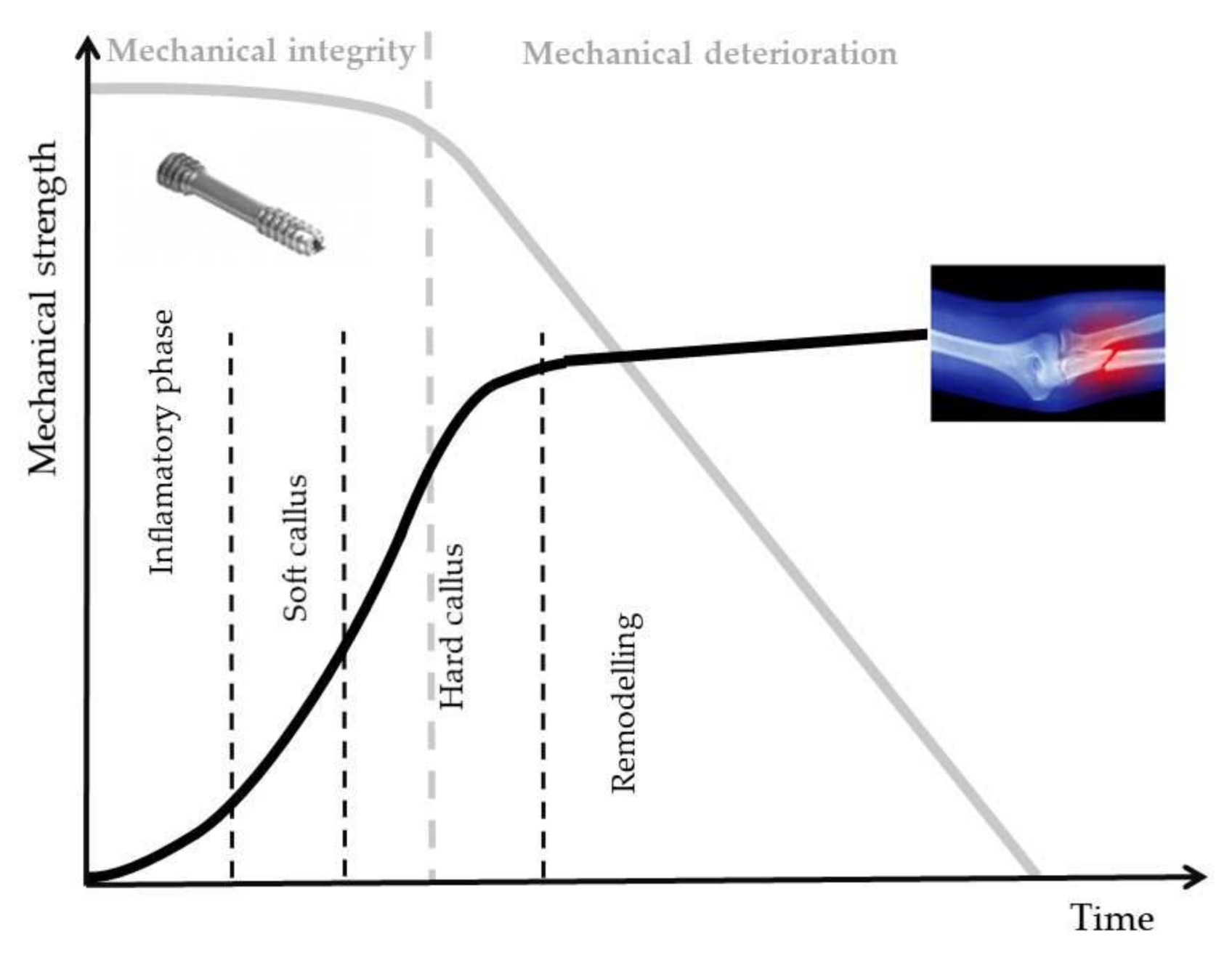
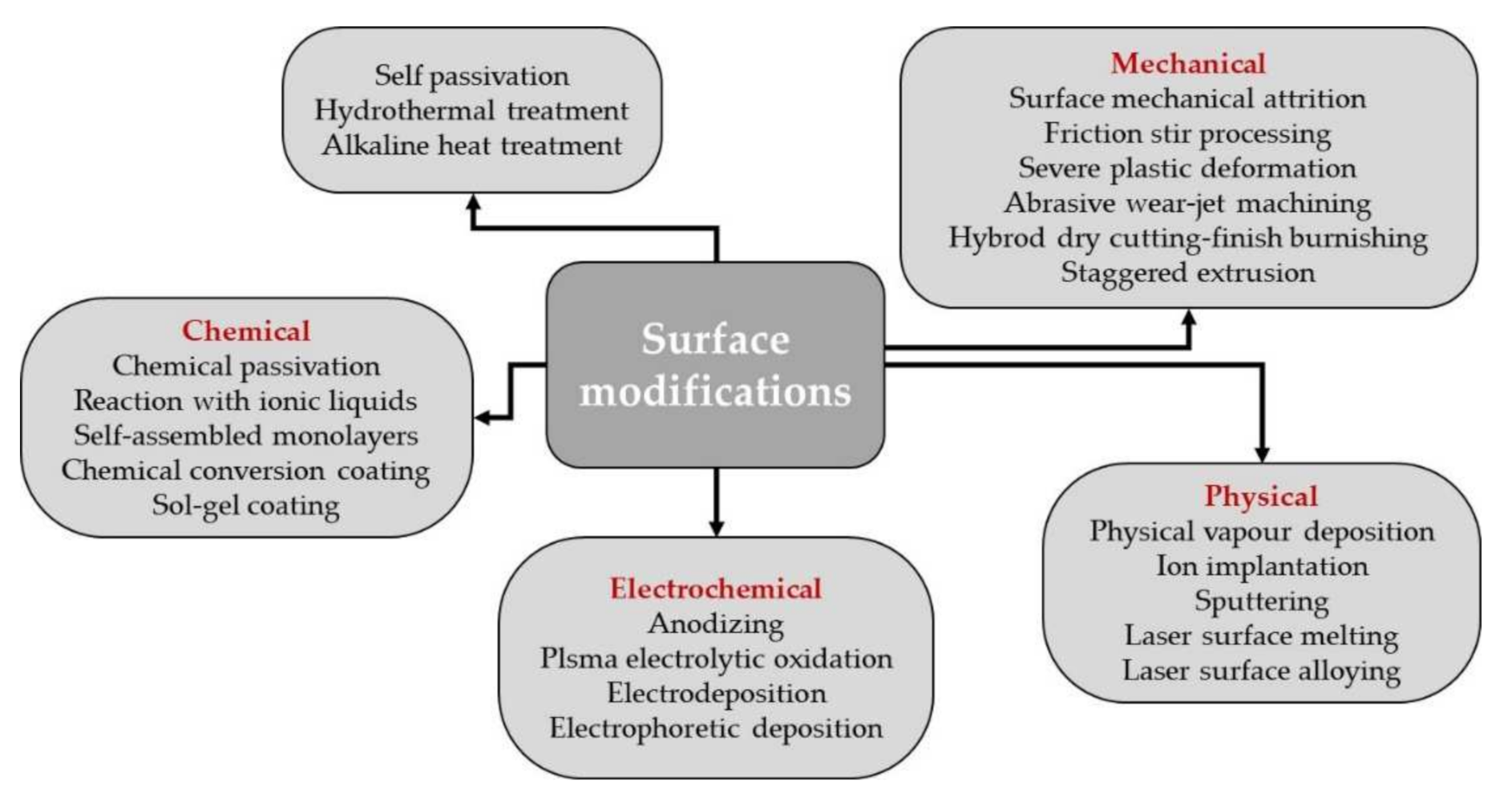
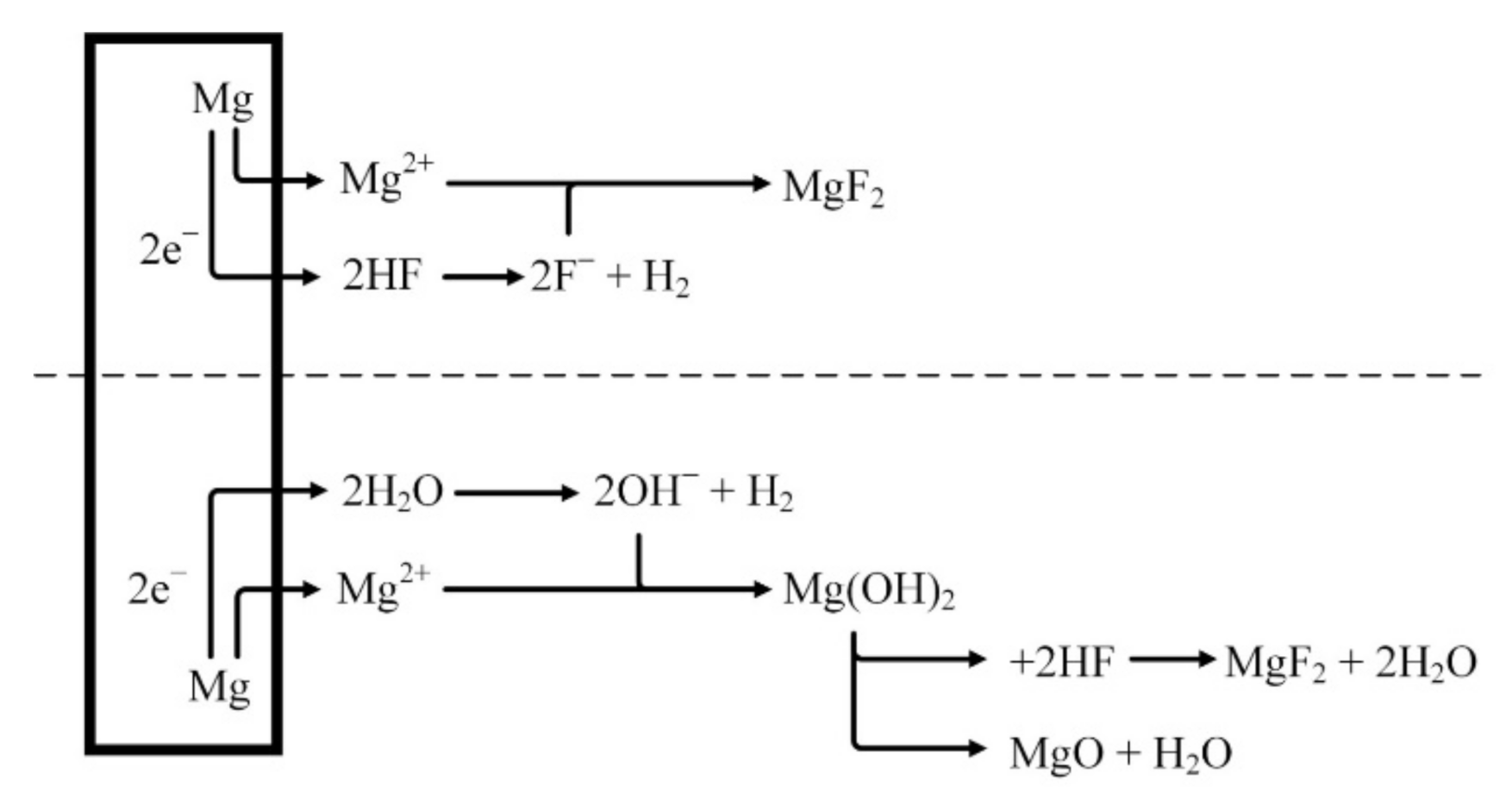
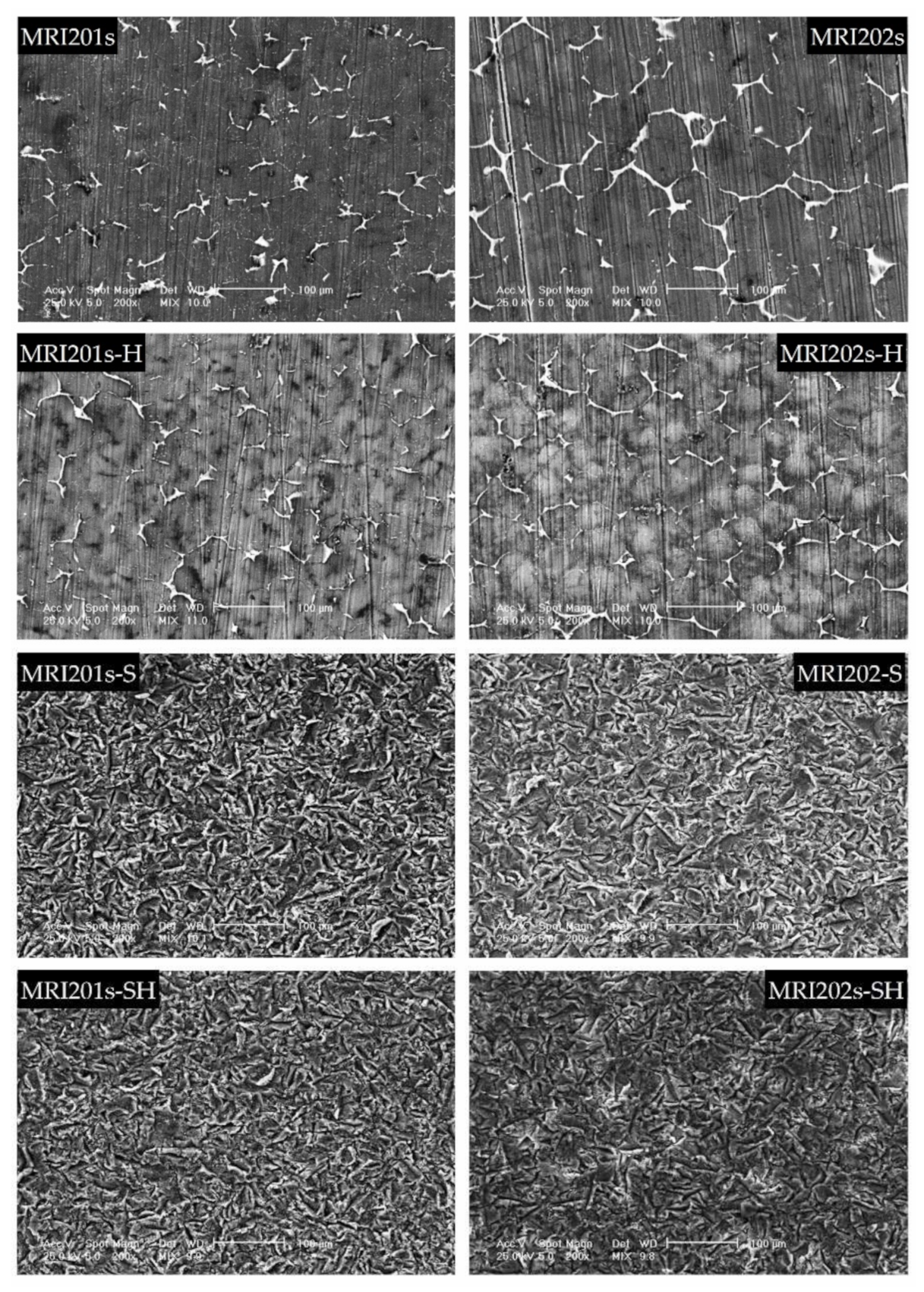
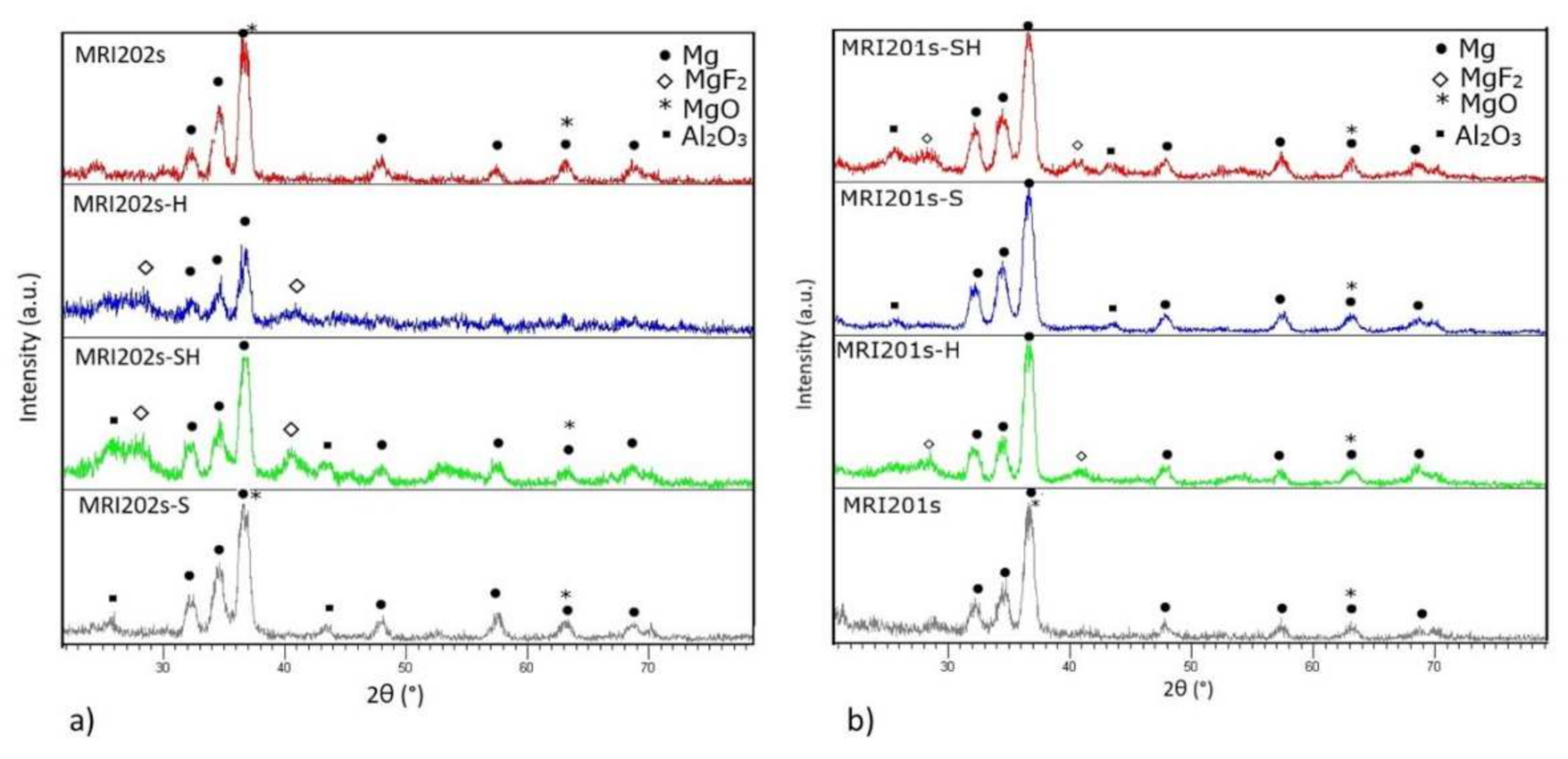
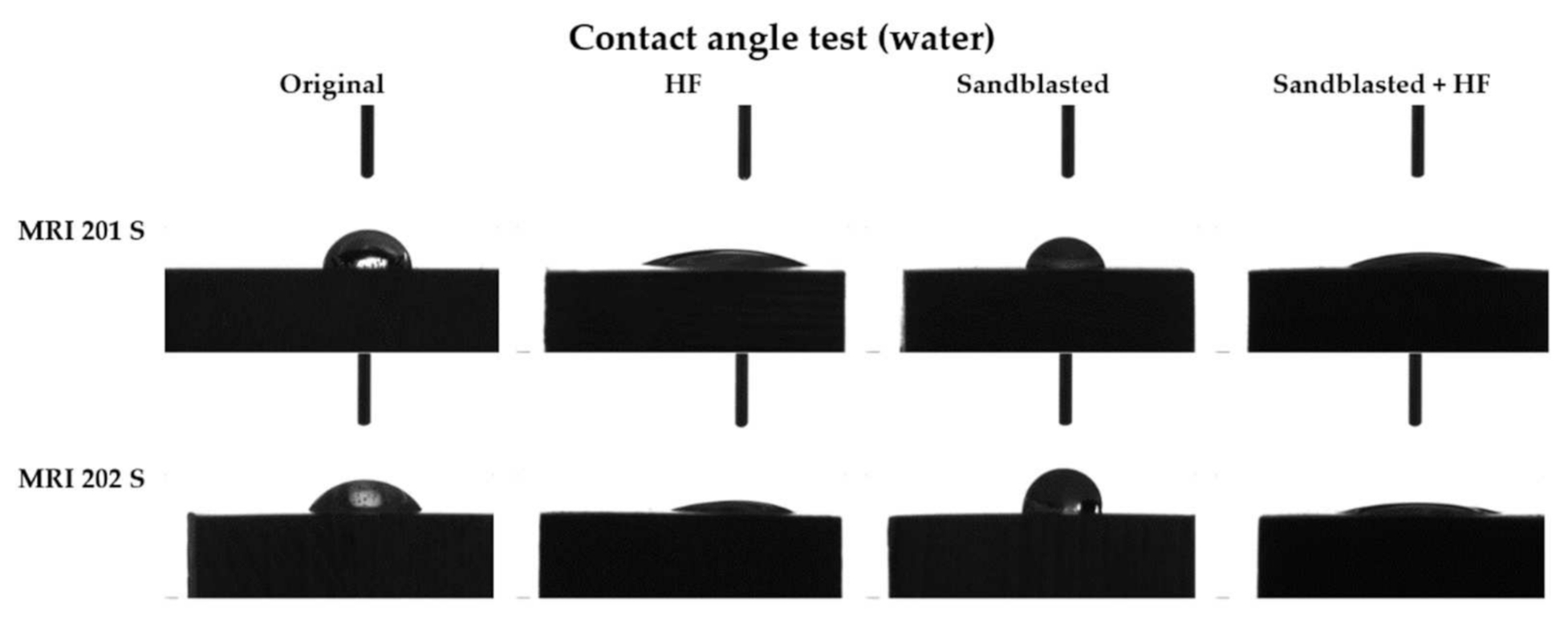
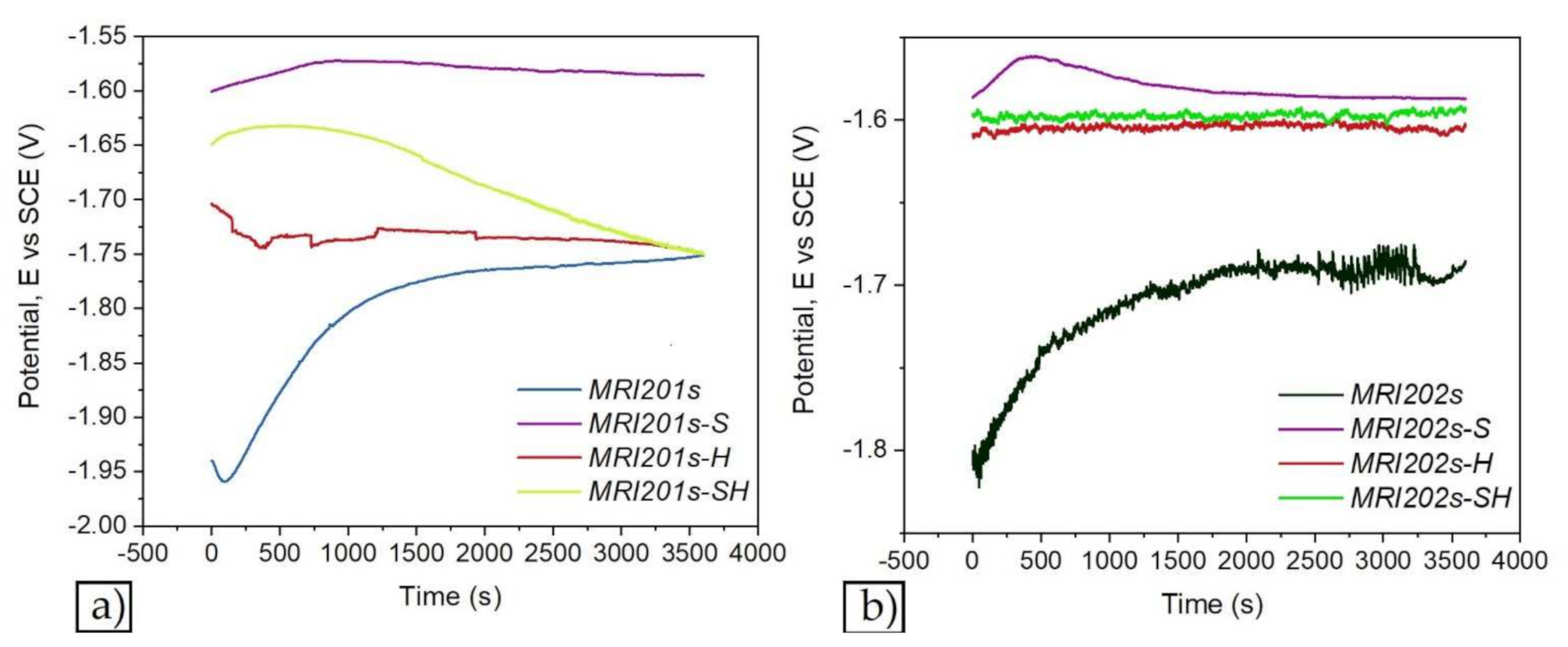

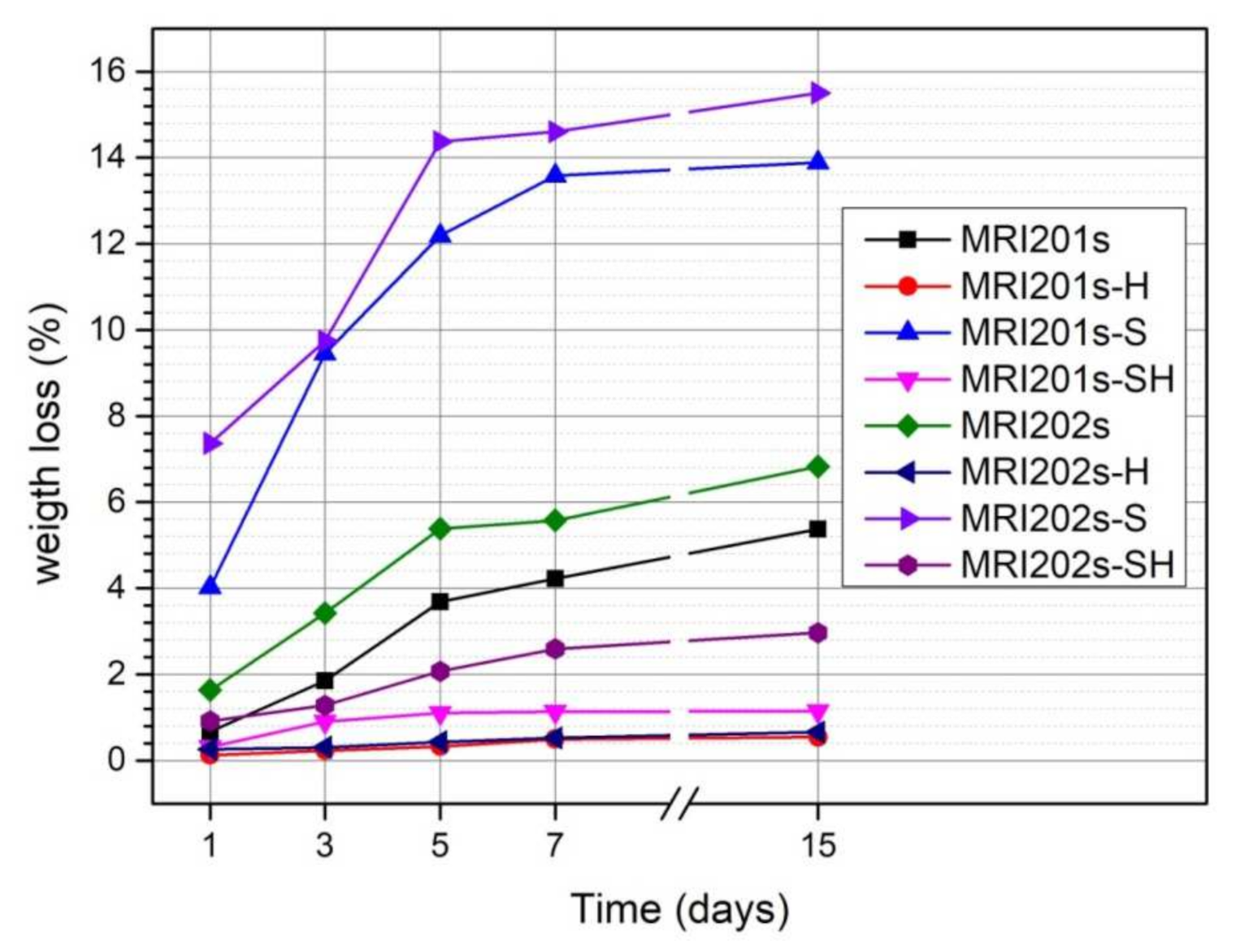

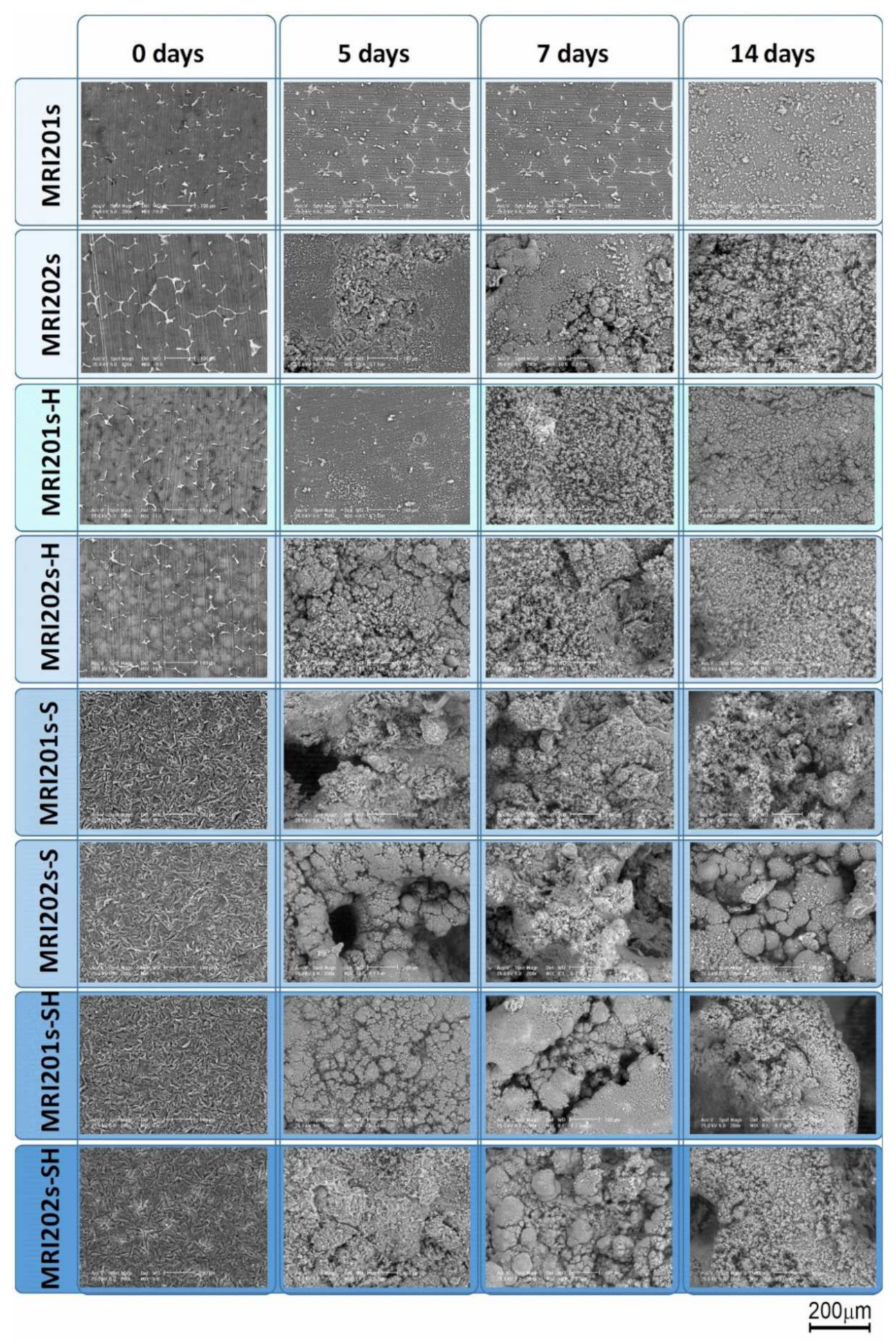
| Samples | Zn (%) | Zr (%) | Y (%) | Nd (%) | Mg (%) |
|---|---|---|---|---|---|
| MRI201s | 0.3 | 0.6 | 2.10 | 3.2 | Bal. |
| MRI202s | 0.3 | 0.4 | 0.21 | 3.1 | Bal. |
| Samples | Macro Image | Treatment Applied |
|---|---|---|
| MRI201s |  | original MRI 201s alloy |
| MRI201s-H |  | MRI 201s alloy treated with HF |
| MRI201s-S |  | Sandblasted MRI 201s alloy |
| MRI201s-SH |  | Sandblasted MRI 201s alloy treated with HF |
| MRI202s |  | original MRI 202s alloy |
| MRI202s-H |  | MRI 202s alloy treated with HF |
| MRI202s-S |  | Sandblasted MRI 202s alloy |
| MRI202s-SH |  | Sandblasted MRI 202s alloy treated with HF |
| Sample | Contact Angle Values (Degrees) |
|---|---|
| MRI201s | 61 ± 0.757 |
| MRI201s-H | 21 ± 0.897 |
| MRI201s-S | 78 ± 0.741 |
| MRI201s-SH | 18 ± 0.729 |
| MRI202s | 55 ± 0.987 |
| MRI202s-H | 23 ± 0.331 |
| MRI202s-S | 80 ± 0.699 |
| MRI202s-SH | 19 ± 0.509 |
| No. | Sample | Eoc (mV) | Ecorr (mV) | icorr (µA/cm2) | βc (mV) | βa (mV) | Rp (kΩxcm2) | CR (mm/y) |
|---|---|---|---|---|---|---|---|---|
| 1. | MRI201s | −1750 | −1726 | 38.926 | 266.77 | 280.00 | 1.525 | 0.874 |
| 2. | MRI201s-H | −1749 | −1733 | 4.203 | 202.01 | 152.73 | 8.997 | 0.094 |
| 3. | MRI201s-S | −1585 | −1562 | 7943 | 2318 | 922.20 | 0.036 | 178.446 |
| 4. | MRI201s-SH | −1750 | −1712 | 15.249 | 290.90 | 202.28 | 3.401 | 0.342 |
| 5. | MRI202s | −1685 | −1622 | 55.703 | 268.93 | 87.48 | 0.515 | 1.257 |
| 6. | MRI202s-H | −1603 | −1447 | 14.87 | 244.67 | 27.68 | 0.727 | 0.335 |
| 7. | MRI202s-S | −1587 | −1552 | 4280 | 938.74 | 477.46 | 0.032 | 96.637 |
| 8. | MRI202s-SH | −1593 | −1481 | 30.354 | 332.79 | 45.68 | 0.575 | 0.685 |
Publisher’s Note: MDPI stays neutral with regard to jurisdictional claims in published maps and institutional affiliations. |
© 2022 by the authors. Licensee MDPI, Basel, Switzerland. This article is an open access article distributed under the terms and conditions of the Creative Commons Attribution (CC BY) license (https://creativecommons.org/licenses/by/4.0/).
Share and Cite
Quan, P.H.; Antoniac, I.; Miculescu, F.; Antoniac, A.; , V.M.; Robu, A.; Bița, A.-I.; Miculescu, M.; Saceleanu, A.; Bodog, A.D.; et al. Fluoride Treatment and In Vitro Corrosion Behavior of Mg-Nd-Y-Zn-Zr Alloys Type. Materials 2022, 15, 566. https://doi.org/10.3390/ma15020566
Quan PH, Antoniac I, Miculescu F, Antoniac A, VM, Robu A, Bița A-I, Miculescu M, Saceleanu A, Bodog AD, et al. Fluoride Treatment and In Vitro Corrosion Behavior of Mg-Nd-Y-Zn-Zr Alloys Type. Materials. 2022; 15(2):566. https://doi.org/10.3390/ma15020566
Chicago/Turabian StyleQuan, Pham Hong, Iulian Antoniac, Florin Miculescu, Aurora Antoniac, Veronica Manescu (Păltânea), Alina Robu, Ana-Iulia Bița, Marian Miculescu, Adriana Saceleanu, Alin Dănuț Bodog, and et al. 2022. "Fluoride Treatment and In Vitro Corrosion Behavior of Mg-Nd-Y-Zn-Zr Alloys Type" Materials 15, no. 2: 566. https://doi.org/10.3390/ma15020566
APA StyleQuan, P. H., Antoniac, I., Miculescu, F., Antoniac, A., , V. M., Robu, A., Bița, A.-I., Miculescu, M., Saceleanu, A., Bodog, A. D., & Saceleanu, V. (2022). Fluoride Treatment and In Vitro Corrosion Behavior of Mg-Nd-Y-Zn-Zr Alloys Type. Materials, 15(2), 566. https://doi.org/10.3390/ma15020566








.png)

